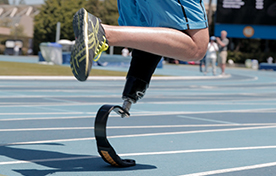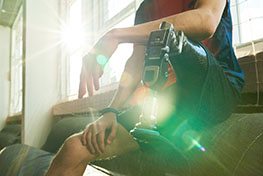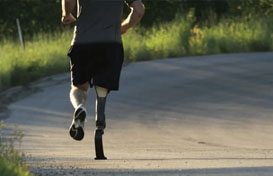When a Prosthesis or Mobility Device Isn’t Enough, Part II
by Jason T. Kahle, CPO, and M. Jason Highsmith, PT, DPT, CP
Straight leg raise into hip flexion to strengthen the hip flexors.
Resistive-band exercise to strengthen the hip flexors.
Resistive-band exercise to strengthen the internal rotators of the hip. Unfortunately, this exercise can stress the co-lateral knee ligaments, which further emphasizes the need to consult a physical therapist for proper technical form.
Straight leg raise into hip abduction to strengthen the hip abductors.
Resistive-band exercise to strengthen the hip abductors.
Straight leg raise into hip extension to strengthen the hip extensors. Lying on the stomach can be a good method to stretch tight hip flexors. Consult your therapist for an appropriate schedule.
Resistive-band exercise to strengthen the hip extensors.
Resistive-band exercise to strengthen the knee flexors. The farther the band is from the knee center, the greater the
resistance. Start with the band close to the socket and progressively move it toward the ankle (as shown here) as you gain strength. Certain pylons might allow the band to slip during exercise. Consult your provider for ideas to prevent this if it is a problem.
non-amputated limb. In this case, the therapist uses his or her hands to guide and facilitate the motion. As strength improves and the person gains experience with the movement, the therapist can apply resistance with his or her hands and, eventually, a resistive band can be used. This exercise is not generally feasible with high, supracondylar trim lines or if the socket is loose.
Straight leg raise into hip adduction to strengthen the hip adductors. This exercise is an easy one to “cheat” on because the hip will tend to flex as the person tends to roll toward his or her back. To do this properly, the person should be sure to lie on his or her side and avoid rolling toward the back. The leg/thigh should be lifted straight toward the ceiling.
Resistive-band exercise to strengthen the hip adductors.
Medial (inward) rotation of the tibia/knee with the knee flexed. This is typically a difficult exercise even in the non-amputated limb. In this case, the therapist uses his or her hands to guide and facilitate the motion. As strength improves and the person gains experience with the movement, the therapist can apply resistance with his or her hands and, eventually, a resistive band can be used. This exercise is not generally feasible with high, supracondylar trim lines or if the socket is loose.
Resistive-band exercise to strengthen the knee extensors. The farther the band is from the knee center, the greater the resistance. Start with the band close to the socket (as shown here) and progressively move it toward the ankle as you gain strength. Certain pylons might allow the band to slip during exercise. Consult your provider for ideas to prevent this if it is a problem.
Step-up exercise to strengthen the hip and knee extensors and the hip and trunk stabilizers. Start on a very low step and be sure to hold on to a rail, walker or spotter the first few times. Progress to a larger step (such as a 6” step) as you gain strength and balance. Always consult a professional before attempting.
Step-down exercise to strengthen the hip and knee extensors and the hip and trunk stabilizers. This is a progression from the step-up exercise. Master the step-up exercise before advancing to this more strenuous type of contraction. Start on a very low step and be sure to hold on to a rail, walker or spotter the first few times. Progress to a larger step (such as a 6” step) as you gain strength and balance. Always consult a professional before attempting.
Part I of this article appeared in the May/ June 2006 issue of inMotion and discussed amputees who need additional support for their residual limb when wearing a prosthesis or using a mobility device. Two examples of additional support include the support offered by higher walls on the prosthetic socket and the support offered by orthotic supplements, such as braces. Unfortunately, while these types of support are necessary for some amputees and can help them better control their residual limb, improve their gait, and avoid harming themselves, they can also be uncomfortable, can be aesthetically unpleasing, and can restrict the movement of the residual limb. In some cases, patients can, and should, take other measures to improve the stability of their residual limb.
By losing weight and/or increasing their flexibility and strength, for example, many patients can make it easier for their prosthetist to design a prosthesis that they can use and that is more comfortable and accommodating to their lifestyle. Patients who want to do this must, however, be honest with themselves about their motivation to accomplish these goals. Exercise for strength, endurance, conditioning and flexibility work best when the person follows a routine and is disciplined about frequency. “Crash diets,” “fad diets” and other “silver-bullet” methods don’t usually work in the long-term and may actually lead to adverse health consequences. Successful long-term weight loss and maintenance generally requires lifestyle modification. (Caution: You should always consult a physician to help you get started with such a program, especially if you have diabetes, cardiovascular disease or any other health condition. It would also be helpful to consult a physical therapist.)
Weight Maintenance
Weight gain has become an epidemic in America and is leading to a vast array of health problems. Two of the best things you can do to prevent problems “down the road” with your general health are to eat a proper, balanced diet and to exercise to maintain an appropriate weight. For those who wear a prosthesis, maintenance of a healthy weight is imperative. Obesity among patients in the prosthetic clinic is a far too common problem, and it makes both the fitting and wearing of a prosthesis difficult for many reasons.
The first reason is simple: Most prosthetic manufacturers make their components for use by people who weigh less than 220 pounds. Therefore, maintaining a healthy weight is critical for maximizing the variety of component options available to you. Though some components are rated for use above this weight class, people who weigh more than 220 pounds have much more limited options. Certainly, component choice is not the only requirement for successful prosthetic use, but it does play a vital role.
Although people who weigh less than 220 pounds can also be obese or overweight, these individuals are not as restricted in their component choices. Still, they must face other problems because of their excess weight.
The second reason maintaining a healthy weight is critical has to do with the firm nature of lean, muscular tissue. Such tissue provides maximal support and stability for a person wearing a prosthesis. The opposite is true of soft, fatty tissue, which provides a less stable interface between the skeletal levers of the residual limb and the prosthesis. This causes problems when the residual limb is supporting the body’s weight while the person is standing in the prosthesis and when he is or she is initiating or terminating movement. Because there is less firm muscular support holding the limb into the prosthetic socket, the residual limb can rotate or slide up and down inside the socket, which can cause a variety of problems, including skin damage and less control of the prosthesis. Routinely, we instruct patients to “fire their muscles” during ambulation to aid in controlling their prosthesis. Anecdotally, we’ve observed that making the residual limb’s tissue firm by contracting the muscles seems to assist in stabilizing the prosthesis.
The third reason to maintain a healthy body weight is that if your inner thighs rub against each other during ambulation, adding prosthetic materials (such as plastics, laminates, sleeves, etc.) between these surfaces may result in skin irritation and/or skin breakdown. This further reduces your options in terms of prosthetic suspension (the way the prosthesis is attached to your body) and will quite likely affect your function, comfort and satisfaction.
The fourth reason has to do with loading on the residual limb during ambulation. At times during the gait cycle, our body’s center of mass normally undergoes rhythmic acceleration and deceleration. Muscles produce force that acts through the joints to control these changes in velocity. Unfortunately, higher body weight produces greater forces and higher loads at joint surfaces. This can unduly stress these surfaces, the muscles that control shock absorption (particularly if they are already deconditioned), the tissues contacting the socket, and the prosthetic components.
Because of its extreme importance, weight maintenance is a perfectly acceptable topic for patients, prosthetists, therapists or physicians to bring up and freely discuss. When healthcare providers bring this issue up, it should not be intended to be accusatorial or derogatory. Rather, it should be in the best interest of their patients and to help them understand the limitations of their present condition. If, for example, a patient is seeing a prosthetist to maximize his or her function and ambulatory potential and being overweight is impeding this goal, then it should be discussed. The prosthetist may be able to refer the patient to another type of healthcare provider to initiate the process toward reaching a more beneficial weight. Primary-care physicians are generally a good place to start since they usually have a better understanding of the individual’s medical history, medication requirements, and additional health conditions, all of which might affect or be affected by weight loss and exercise. On occasion, these physicians might refer their patients to a registered dietitian or diabetes counselor who can advise them more specifically on the types of nutritional programs that have been more successful for certain types of individuals, such as people with diabetes.
On the other hand, significant weight loss may also have a negative effect on prosthetic fit. Prosthetic fit, simply stated, is volume matching. When volume is lost, the prosthetic socket will have to be adjusted and/or refitted. If you are planning to lose weight, it is, therefore, important to communicate this with your prosthetist who can then design your prosthetic socket in a way that can maximally accommodate larger- or faster-than-normal volume loss. A number of methods can be used to accommodate volume loss. Some sockets can be reduced and/or padded, thicker liners may be used, or air bladders may be installed.
In some cases of weight loss, a socket replacement may be considered a “medical necessity.” This means that the prosthetist and other healthcare providers may be able to prove to your insurance company that a medical condition is the reason for your socket replacement and increase the likelihood that the insurance company will pay for it. In these cases, it is imperative that you let your prosthetist establish your baseline body weight, limb volume, and limb girth measurements before you initiate a weight loss program so that he or she can “scientifically/ objectively” track your body’s changes to provide evidence of medical necessity for the impending socket replacement.
Often times, the process of weight loss is inconvenient for patients due to the need for numerous additional visits to the prosthetist for socket adjustments as volume is lost. If the weight loss is not proactively managed, the prosthetic socket will likely cease to fit properly and may cause skin irritation and breakdown. This should never, however, be the sole reason to decide against following a weight-loss plan. As stated previously, when your body mass goes below 220 pounds, component options will increase greatly. In addition, as the composition of the residual limb changes from soft tissue to firm muscular tissue, control of the prosthesis should improve and options should increase for the socket suspension and the height of the socket walls. Therefore, the potential benefits of modifying your lifestyle to lose weight far outweigh the minor inconveniences it may cause.
Therapeutic Exercise and Its Role in Stability Strengthening and Knee Stability
The go-to prosthetic solution for compromised knee ligaments on the inner and/or outer side of the joint and the instability that comes with this problem is the use of a joint and corset prosthesis or raising the trim lines of the socket above the femoral condyles (the round ends of the bone) at the knee joint. Both of these solutions prevent a knee with compromised mediolateral (side to side) stability from moving into a bowlegged or knock-kneed position, as shown in Figure 1 and Figure 2. However, the joint and corset prosthesis typically provides better mediolateral stability than raising the trim lines.
The question then follows: “Can’t exercise strengthen these areas?” The shorter answer is “Maybe.”
Unfortunately, when ligaments are damaged, they cannot be strengthened in the same way as muscle. Ligaments are passive structures that act, in a way, like cables across a joint to prevent or control undesirable movement. When such movement occurs in excess, ligament damage results. When ligaments are damaged, the recommendation from a therapeutic exercise perspective (only following appropriate healing) might include strengthening the muscles that cross the joint so that they can support the function of the traumatized ligament. In the case of the knee, several muscles do cross the inner and outer sides of the joint, but they are not extremely effective at checking unwanted mediolateral movement.
The muscles that check outward movement include the tensor fascia latae (TFL) and the lateral hamstrings (lHS). To strengthen these muscles, the following actions would be performed:
- TFL-Hip Flexion (Figure 3 and Figure 4), Hip Internal Rotation (Figure 5), and Hip Abduction (Figure 6 and Figure 7)
- lHS-Hip Extension (Figure 8 and Figure 9), Knee Flexion (Figure 10), and External Rotation of the Tibia (Figure 11).
The muscles that check inward movement of the knee predominantly include the sartorius, gracilis and semitendinosis, which are collectively referred to as the pes anserinus group. To strengthen this group, the following actions would be performed. Action is performed at both the hip and knee, similar to in the previous exercises.
- Pes Anserinus – Hip Adduction (Figure 12 and Figure 13), Knee Flexion (Figure 10), and Internal Rotation of the Tibia (Figure 14).
This is a quick summary of mediolateral stability. There are, however, other planes of movement to consider, predominantly the anteroposterior (AP, or front to back). Since the primary and largest function of the knee is to flex and extend, several very large muscles affect these motions, and, yes, ligaments are still very much involved. Gross front-to-back instabilities stemming from ligament problems in this plane may require surgical intervention, but less severe instabilities in this plane may respond well to strengthening exercises. If the anatomical knee tends to buckle (flex) inappropriately at any time during the stance phase, strengthening the quadriceps muscle group (knee extensors) should be considered. Some people tend to stand with the knee in hyperextension due to extensor weakness. This is another situation in which quadriceps strengthening could be considered. One part of the heads of the quadriceps muscle crosses the hip joint and, therefore, this muscle has action at both the hip and knee. Quadriceps strengthening exercises include:
- Straight Leg Raise (while lying on the back) (Figure 3)
- Knee Extensions (Figure 15)
- Step Ups and Step Downs (Figure 16 and Figure 17)
The muscles that perform knee flexion must also be considered. These muscles tend to be less problematic from a kneestability perspective with transtibial (below-knee) amputation and more so with transfemoral (above-knee) amputation because their function at the hip is extension. In other words, some of the muscles that cross and flex the knee also cross the hip and cause hip extension. Hip extension plays a crucial role in augmenting knee extension and is very important for fall prevention. Consider the instant that your heel strikes the ground. After shock is absorbed, the knee needs to extend as does the hip. Likewise, when you are climbing stairs, to ascend to the next step, the knee and hip must extend. Finally, this ability is critically important when walking with certain types of prosthetic knees that require the user to forcefully extend the hip to facilitate prosthetic knee extension and stabilize the knee for stance. Exercises to strengthen the hip extensors (and knee flexors) include:
- Straight Leg Raise (while lying on the stomach) ( Figure 8 )
- Knee Flexion (Figure 10)
- Step Ups and Step Downs (Figure 16 and Figure 17).
(The authors believe that the preceding exercises are key movements, but there are numerous other actions for these muscles and each case may be different. Formal instruction and supervision for technical form, tolerance and progression are crucial. Consult your healthcare provider.)
Flexibility Through Stretching
Scott Waite, MPT, addressed this topic in the September/October 2006 issue of inMotion. Waite’s article contains excellent stretching activities that address common problems in the amputee population, and we recommend that readers review this important material.
Here, we will only briefly discuss flexibility and range of motion (ROM) and its influence on knee stability.
With the loss of a lower extremity, the odds of developing a contracture (a shortened muscle or tendon) are quite high. Proactive effort is required to prevent contractures and preserve the patient’s existing range of motion.
If a severe enough contracture occurs at the knee and/or hip, the prosthesis must be designed to accommodate the contracture to permit comfort and reasonable function. Contractures, even prosthetically accommodated ones, will impact the patient’s gait and other aspects of health. If, for example, the hip is unable to fully extend due to a flexion contracture, the person’s step length will shorten, affecting the gait pattern and efficiency. The person may then compensate by hyperextending the lumbar spine, thereby restoring some of the lost step length though still not actually gaining any hip extension. The problem is that the spine was not designed to move in this fashion, and this movement may therefore cause spinal injury.
Prosthetic accommodations for deficient range of motion require that components be situated in nonanatomical locations. For example, rather than placing the prosthetic knee at the bottom end of the socket, it may be placed behind the socket and not on the bottom. In such a case, knee instability becomes a mechanical problem resolved by moving components in such locations that buckling is less likely, but the devices look and act less anatomic and more mechanical. Ultimately, this provides the user a minimal amount of voluntary control in instances of potential falls. This can potentially lead to several problems:
- Dependence on mechanical stability for fall prevention
- A prosthesis that does little to minimize or resolve a contracture
- A less dynamic, “lazy” gait where the user is influenced by the prosthesis rather than influencing the prosthesis
- Further atrophy
- Further deconditioning
- Dissatisfaction.
The importance of maintaining flexibility through stretching cannot be overstated.
What Can a Person Do?
What can you do to influence the stability of your residual limb? The short answer is “Maintenance.” You need to maintain a healthy weight, the integrity of your joints, your strength, and your flexibility.
This is only a brief discussion of select, common aspects of stability that can be influenced directly by the wearer of a prosthesis. It is absolutely imperative that you discuss your particular case with a healthcare professional to ensure appropriate intervention and the best results. If, however, these things are at the forefront of your thinking, then your potential for success with a prosthesis will likely be improved.
About the Authors
Jason T. Kahle is a certified and licensed prosthetist/orthotist. He is the director of lower-extremity prosthetics at Westcoast Brace & Limb in Tampa, Florida.
M. Jason Highsmith is a physical therapist and board-eligible prosthetist. He is an assistant professor in the School of Physical Therapy at the University of South Florida.
Disclaimer: The following information is provided and owned by the Amputation Coalition of America and was previously published on the website http://www.amputee-coalition.org or the Coalitions Newsletter, inMotion.








